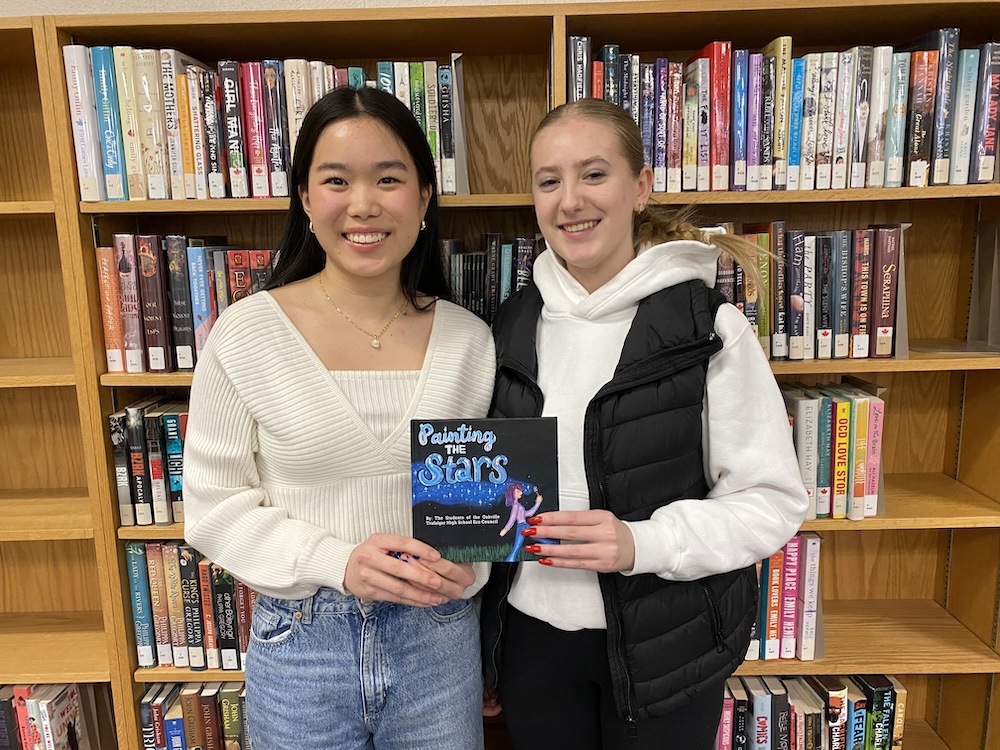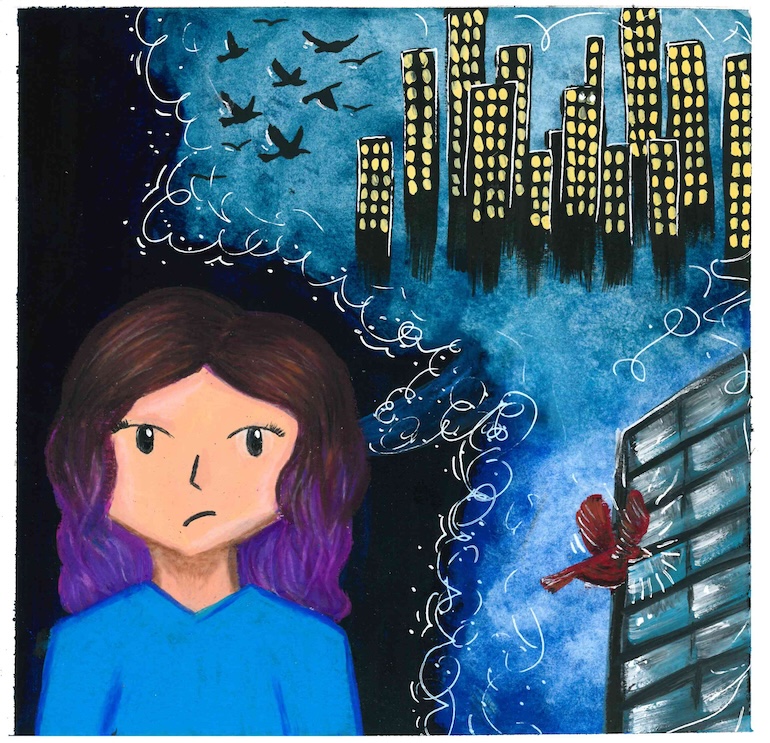Light Pollution is an important environmental issue. Unfortunately, it hasn’t been a top priority for most student projects, partially because rural students are able to see the stars and also because it hasn’t been overly profiled by the government and media.
However, when the Eco Council team at Oakville Trafalgar High School in Ontario discovered that light pollution negatively affects birds and nautical wildlife, it sparked major student concern.
The Eco Council was motivated to address this issue in 2022 when one student, who has since graduated, invited a speaker from Fatal Light Awareness Program (FLAP) to explain how light from skyscrapers causes some birds to collide with buildings at night. Interest was piqued when these teens gravitated towards early education and voted to adapt their artistic skills to create an illustrated children’s educational book focussing on how preschoolers and elementary grades can help.

Emily and Sarah holding book their new book, Painting the Stars.
Once the idea to publish a book took hold, illustrators created a storyboard featuring a young girl who wanted to see the stars again. With strong support from science teacher Allison Proctor and the entire high school staff, a 24-page, full- colour, hardback children’s book entitled Painting the Stars became a reality. The project took about one year from the initial idea in the spring of 2022 to the final printing in June 2023.
Painting the Stars embodies a spirit of sincerity and zest expressed by teens. The following is a brief outline.
Luna, a teenage girl, and her father were returning to their favourite campsite on the edge of town to view the stars. When none became visible, Luna asked, “Where are the stars?” Her dad explained that light pollution occurs when artificial light from cities makes the night sky brighter. He demonstrated that if you hold a lantern in the light, you won’t see its glow clearly.
Luna realized that light pollution is a hazard not only for birds that fly into buildings but also for raccoons, frogs, and owls. Even newborn turtles that rely on the moon to find the ocean become confused.
Luna and her dad discussed solutions that offered energy-efficient tips, such as turning out lights when not in use and closing the drapes at night to keep light inside the home.
Luna told all her classmates, family, and friends about how they, as individuals, can be part of the solution. The following year, father and daughter returned to their campsite and were able to gaze at the stars.

Illustration from Painting the Stars.
With the collaboration of authors, illustrators, and editors from the Eco Council, 25 copies of this delightful book were printed by Blurb, an online source specializing in photo books. A grant of $500 from Learning for a Sustainable Future (LSF) and student bake sales, which raised $150, covered the expenses. Books were distributed free of charge to feeder schools of Oakville Trafalgar High School.
One of the editors, Sarah Wild, explains, “It was definitely a team effort. We learned a lot about storyboarding and the process of going from an idea to a finished product. It was a beneficial experience for everyone.”
Emily Chen, author, illustrator, and editor commented, “It was a challenging and fulfilling project. From the beginning, every step had roadblocks, but everyone contributed and we were able to work together to bring the project to completion. It was very fulfilling to see the final product, and the book is truly a reflection of the dedication of everyone involved.”
Others involved included Ava Steiginga (author), Lynn Cheng (editor and illustrator), Amadahy Schultz (illustrator), and Allison Proctor (editor).
Painting the Stars was a great project to focus attention on the important issue of light pollution. The Eco Council has not digitized the book but might create a short film with students reading the book, which could be shown at schools. When a second grant from LSF became available, the Eco Council decided to implement a new action plan related to food sustainability, which may lead to the publishing of another book.
The students continued to raise awareness about light pollution and methods to protect birds during the spring migration season by turning off lights and helping to reduce bird collisions. They are also excited that knowledge about light pollution is reaching a wider audience.
Proctor concluded, “The students had the idea to call this book Painting the Stars. I think it is a perfect metaphor for the actions that we can take to make the world a better place. I am privileged to have the opportunity to work with such creative, talented, and passionate young people every day.”
By late September, it becomes quite noticeable that the daylight hours are becoming shorter. This is a good month to remind all rural students to appreciate the night sky and apply energy-saving tips to help protect nocturnal wildlife in their areas.
On a higher reading level regarding light pollution, Dark Matters: Nature’s Reaction to Light Pollution by Joan Marie Galat was published by Red Deer Press in 2017. As an ecologist, Galat examines the effects of light pollution in our cities and our inability to view the night sky, together with its effects on sea, land, and airborne animals. Dark Matters has fourteen excellent chapters containing facts, illustrations, and suggestions on how young people can reduce light pollution. A full review by Canadian Teacher Magazine can be seen at the link below.
At whatever age and wherever we live, each of us holds magic paintbrushes in our hands. They are fingers to turn off lights when we exit a room and draw drapes as darkness approaches.
Related Links
Fatal Light Awareness Program (FLAP) https://flap.org
https://canadianteachermagazine.com/2018/01/18/dark-matters-natures-reaction-to-light-pollution/
ABOUT THE AUTHOR
Larraine Roulston
Larraine writes children’s illustrated adventure books on composting and pollinating. To view, visit: castlecompost.com
This article is featured in Canadian Teacher Magazine’s Fall 2024 issue.









